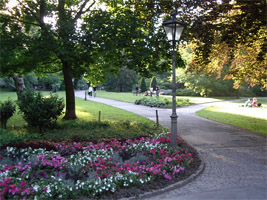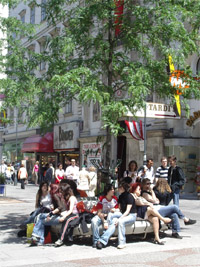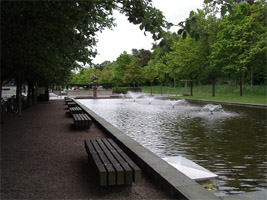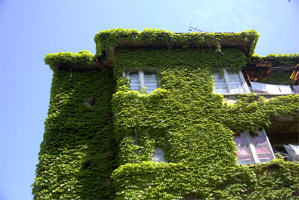 |
 |
 |
 |
 |
 |
 |
 |
 |
 |
 |
Important issues

Links between issues of the urban green/blue infrastructure and sustainability could be traced in terms of both the spatial and functional structure of cities and towns. European policy on sustainable urban development has increasingly focused its attention on the importance of open green space since early 1990s. The natural areas protection and enhancement was set as one of the main targets for future action by the Green Paper on the Urban Environment (EC, 1990).
Open spaces and green areas in European cities are mentioned to be under continuous threat due to more competitive uses of limited land resources in Europe’s Environment: The Dobris Assessment, the first pan-European state-of-the-environment report that covered 46 countries (EEA, 1995). The document discusses loss of green space both within and around urban areas and resulting threats to biodiversity and to quality of life of citizens. The reported tendency and the estimated importance of green systems to urban sustainability has motivated numerous European studies in recent years. Four dimensions of urban green space functions and development are in the focus of current research: spatial, ecological, cultural and social (COST C11, Final Report).
Based on PETUS literature review and case studies, three main issues in the field of urban green/blue infrastructure could be outlined as being of particular importance to planning and management practices aimed at urban sustainability:

• Quantity of the urban green space
Urban green space varies considerably in size and type alongside with the diversity of urban patterns through Europe. The balance between open and built up areas in cities and towns results from local peculiarities of climate, relief, geology, hydrology, topography, etc. but also from varied cultural traditions and life patterns. Densification of city centres and exerted building pressure on urban green space together with urban sprawl into the green space surrounding cities is a general tendency reported in many European cities. The sustainability debate posing the compact vs. the ecocycle city has no definite outcome yet. Some authors consider the compact city an important factor for urban sustainability (Naess, 2000). Others are however concerned with the consequences of losing green areas in cities – diminishing recreational capacity and increasing urban stress, regarded as reasons for increasing motivation of inhabitants to move out to the urban outskirts - thus causing even faster urban sprawl and greater transportation expenses. The ecocycle city concept is based on the idea that green urban space could provide valuable space for increasing the circular metabolism of cities.
The urgency of planning and management actions to reconquer degraded, polluted and abandoned ex-industrial areas for contemporary urban life by turning them into green recreational areas is broadly accepted by both experts, politicians and the public throughout Europe. Emerging conflict points in many cases seem to be related to the new functions of such places and the balance to achieve between the economic benefits for the local community and the additional long-term pressure on the environment exerted by large flows of outside visitors/ tourists.

• Quality of the urban green space
The increasing range of "quality" requirements to the urban green/blue infrastructure results from the complexity of functions attributed to them and the deeper knowledge continually gained about their capacity to influence different aspects of both human life and the urban environment. The main challenge to the projects aimed at the regeneration of urban green spaces is to provide a wider range of opportunities for recreation, leisure and entertainment (providing for better quality of life of urban citizens) by defining the optimal number, type and capacity of needed sports and leisure facilities within the green system, while guaranteeing the maintenance of the ecological equilibrium and the preservation of biodiversity (providing for better quality of habitats as a basis for biodiversity).
• Effectiveness of the urban green/blue infrastructure
 The issue is related to a generally estimated lack of adequate instruments to guarantee the real effect of the infrastructure work. The use of urban green/blue space is not directly paid for by citizens but only through local taxes. Feedback on estimated efficiency of functioning is not easy to get. Another important challenge to authorities is how to meet the increasing demands to the quantity and quality of green/blue space in cities and towns without rising local taxes within the constraints of usually modest financial frameworks.
The issue is related to a generally estimated lack of adequate instruments to guarantee the real effect of the infrastructure work. The use of urban green/blue space is not directly paid for by citizens but only through local taxes. Feedback on estimated efficiency of functioning is not easy to get. Another important challenge to authorities is how to meet the increasing demands to the quantity and quality of green/blue space in cities and towns without rising local taxes within the constraints of usually modest financial frameworks.
Raising the efficiency of use of the green/blue infrastructure could be possible through changes in the management approaches applied and by building up new types of partnerships at the local level. There are two groups of general issues concerning the planning and management processes that need to be further investigated:
(a) Needed holistic approaches to urban green/blue issues – to integrate environmental considerations (biological diversity) with economic/commercial, social (health, safety) and cultural aspects; the possibilities for multidisciplinary co-operation between researchers from the natural, the technical and the social sciences;
(b) Communication in decision-making – with concern for power-public-private relations in urban management. The interaction between residents, interest groups, planners, municipal departments and other actors and discourses in strategic and operational planning approaches still need to be developed.
For more information:
Green-blue spaces quantitative aspects: Rations in urban areas
Green spaces qualitative aspects: Improvement of the quality of existing green/blue spaces
Efficient functioning of green spaces